
Zinnias are everywhere these days, and they make the world brighter. Here are a few different varieties of zinnias from here and there.







Zinnias are everywhere these days, and they make the world brighter. Here are a few different varieties of zinnias from here and there.







Here is a fine example of the last gasp of Gothic architecture in America. This church was built as late as 1951 in a style that would have seemed reasonably conservative twenty years earlier. The building has passed into the hands of the Immanuel Orthodox Presbyterian congregation, and members were spiffing up the grounds while old Pa Pitt was taking these pictures.


The west-front entrance is very similar to what William P. Hutchins did more than two decades earlier at St. Francis Xavier Church in Brighton Heights; perhaps they were both inspired by the same historical example.







Around the corner, behind the church, is a Sunday-school building that dates from 1928 in a style we might call Educational Gothic.




A century ago, radio had become a huge business—yet by the middle of 1925 commercial radio was only a little more than four years old. The growth of the industry astounded even the people most involved in it; the only phenomenon of our time that can remotely compare is the growth of the World Wide Web in the 1990s. (And here is a hint to producers of period movies: your mid-1920s backdrops are not complete unless all the buildings are festooned with improvised radio aerials.)
In the June 1925 issue, Radio Age interviewed “the world’s pioneer radio announcer,” H. W. Arlin, who started announcing for KDKA shortly after it began a seven-day broadcasting schedule. In the interview, he describes some of the daily duties that keep an announcer’s job incessantly entertaining. We should remember that, in those early days, a powerful station could be heard across the country, so Mr. Arlin regularly had to answer telephone calls and telegrams from distant places.
We wonder, incidentally, how much of his insistence that he was never tired was publicity puffery. In spite of his celebrity status, Mr. Arlin left the radio business shortly after this interview was published—though it may have been because he was offered a management position in Westinghouse, and the money was too good to pass up. He lived sixty more years, returning to national radio only once, to announce the returns from the Eisenhower-Stevenson election in 1952.
Announcing radio programs might be called the world’s most recent profession, because announcers for broadcasting stations were introduced first about four years ago when KDKA, the world’s pioneer station of the Westinghouse Company at East Pittsburgh, Pa., was started.
H. W. Arlin, the world’s pioneer radio announcer, made his debut early in 1921 and has been continuously “on the air” since. Thus his long service entitles him to the honors of being the veteran of radio announcers.
Mr. Arlin’s studio experiences have been many and varied. Life as a radio announcer is not a drab affair, as there is a necessity of being continually on the “qui vive.”
In the following interview Mr. Arlin tells of some of his studio experiences and some interesting contacts with his radio public.
“I am often asked the question, ‘Do you become tired of announcing?’ or ‘Does radio work become monotonous?’ My answers to such questions are always in the negative, thanks to an ever-curious and an assisting public. By such an answer, I mean that any motonony which might otherwise tend to creep into the almost continual execution of programs is quickly dispelled by a multitude of extraneous duties with which an announcer is confronted.
“Probably one of the most interesting phases of studio work comes through contact with the public, not entirely by personal association, but also through the telephone and telegraph. No work can become monotonous or tiresome where the public is involved. On the contrary, I have found that a study of the whims and fancies of the public has been an exceedingly interesting one. Paraphrasing the famous expression of Abraham Lincoln, ‘You can please some of the people all of the time, and all of the people some of the time; but you can’t please all of the people all of the time.’ Not radio, at any extent. This statement could be applied to the view of the public on any one phase of radio entertainment such as music or sports. When applied to all of the phases of radio, it becomes many more times effective. What one person likes, another dislikes, and what one person condemns, another approves; so an announcer is almost justified in concluding that a ‘fifty-fifty break’ with the listening public is fair enough. However, 100 per cent satisfaction is always the goal.
“In telling of the announcer’s contact with the public we may take into consideration only one phase of this contact; that of telephone conversations. The nature of the telephone messages received, together with the conversations that follow, tend to create in one a desire for the study of people. The thoughts and ideas which prompt these many calls are perhaps innumerable; perhaps some one conceives an idea by which radio can be of aid to him in his own personal advancement or the advancement of some pet theory, or possibly some one desires some information which may vary from that of a query regarding what is the proper food to give a sick baby to that of certain details regarding a program to be broadcast several weeks hence.
“A few of the seemingly endless number of such questions and requests may be of interest. A confiding interest in our listeners, (this same public) will necessitate the omission of the names of any personalities involved in the following:
“One of our good Canadian friends recently called to tell us about a circular parking station he had invented for automobiles which would handle two hundred cars and which could be operated by one man. Appreciating the need for better parking service and predicting great success for his venture, he requested that we advise the radio public of his invention with full details as to where to purchase these stations.
“A lady calls us and requests that we announce that she has just left a package of pajamas on the street car and would like to have the service of the radio in recovering them. After being informed that we never make local announcements except in cases of robberies, kidnapping, lost persons and such emergencies, she replies, ‘Well, this is an emergency case, because it is the only package I had.’
“An elderly lady, apparently a student of nature, calls and gives us the following important news item: ‘Will you please announce that there is about four inches of snow in my back yard and that I have just seen two cardinal red birds?’ Of course, a very unusual sight for this time of the year.
“No sooner is the telephone receiver on the hook than the bell again rings and an innocent feminine voice pops the following impression: ‘I just heard you announce that you had received a telegram from New York commenting on the program. I would like to know if you are also broadcasting to Ohio tonight, as I would like to request a number for some friends out there who do not have the advantages of a radio.’
“It has also been brought very forcibly to my attention that radio has made a greater impression upon the public than has music. Of the many proofs of this statement, I might cite an occasion on which a program was being presented by the great Fritz Kreisler. The telephone rings and the following question comes from one of our listeners: ‘Do I have to listen to that novice all evening?’ A very provoking question to ask an announcer on such an occasion. He was then asked if he knew who he was listening to and after replying in the negative, he was very politely told that if his set was not working properly or that if he didn’t appreciate the music, he was in no way obligated to keep on listening the rest of the evening. This, apparently, answered his first question satisfactorily, and was an answer which fortunately savored very little of the thoughts that were running through the announcer’s brain.
“A lack of appreciation for the success of artists or for the repertoire used by them sometimes results in requests which provoke a smile from the person to whom they are addressed. When presenting a program at KDKA recently, Mrs. Christine Miller Clemson who before her marriage was one of the country’s contraltos and a concert singer with an enviable record, was requested to sing the jazz number ‘Red Hot Mamma.’
“Perhaps one of the most common requests received is that requesting an artist to sing a particular number. In spite of the fact that there are thousands of songs, a good many listeners cannot quite understand why the singer does not have the particular number they request. Song pluggers are requested to sing ‘Arias’ and grand opera stars are requested to sing jazz numbers by the well-meaning audience. It also happens quite often that in spite of the fact that we receive hundreds of requests for numbers during a particular evening, some well meaning individual is at a loss to know why his or her particular request was not granted.
“Oftentimes a party will call and ask the following question or a similar one: ‘I have a five-tube neutrodyne set and cannot hear anything. Will you please tell me what is the matter with my set?’ The opinion seems to be quite prevalent among a good many listeners that the wavelength determines the distance which a station can be heard, and usually the belief prevails that the distance a station can be heard varies directly with its wavelength. This opinion is the cause of some very humorous questions being asked.
“Among the innumerable questions are such questions as these: What time is it? Where is station WXY located? What is the name of the waltz the band played last Saturday night? What is the wavelength of station WXY? How far are you broadcasting tonight? Who is going to give your program on the 2nd of next month?’
“And so the announcer soon finds himself converted into an information bureau from which the dissemination of news adds a very colorful diversion to his vocation.”

Though the Manor has long been subdivided into four small theaters, part of the original ceiling remains in the lobby, and this chandelier, according to staff at the theater, is an exact replica of the original.

The school for Neville Township, the municipality whose borders are the shores of Neville Island, was built in three main stages. The little school above, with four or five rooms, was the first.
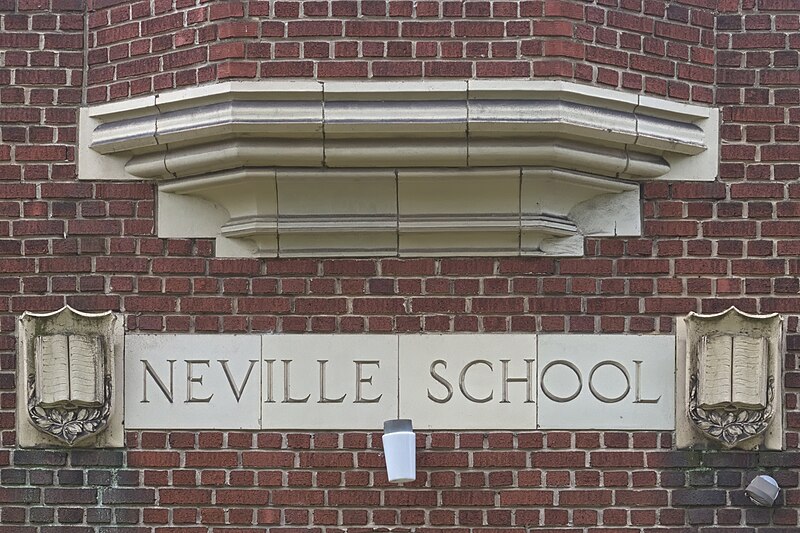




Some time later, a two-storey building in a matching Jacobean style was built around the corner. (Addendum: Father Pitt has some reason to believe, but no definite proof yet, that the architect of both the prewar school buildings was John H. Phillips of McKees Rocks, who designed many schools for suburban boroughs.)



Finally, a postwar modern section was added, probably around 1960 to judge from the style. It was not in use for a long time: old Pa Pitt had a very pleasant conversation with a neighborhood resident whose wife was a member of the last graduating class of this school in 1971. Neville Township and Coraopolis merged their school systems into the Cornell School District, whose name is a portmanteau of the two municipalities. Fortunately, the buildings have found other uses.

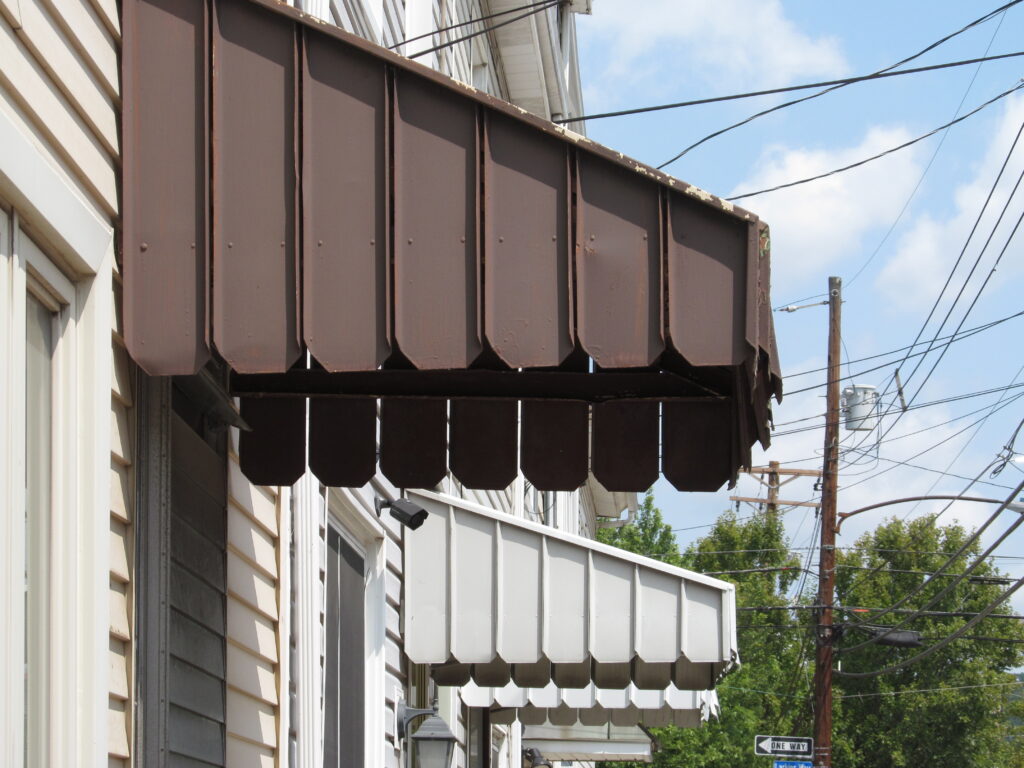
Awnings used to be a big business in Pittsburgh. The awning men would come to your house in the spring and put canvas awnings over your doors and windows for summer shade, and then in the fall they would come around and take down the awnings and take them away to be cleaned and put in storage, and then in the spring you would get fresh awnings again. (You can still find one or two services that will do that for you.)
Obviously you have to spend some money on this service, and that limited it largely to the upper middle classes and above. When someone had the brilliant idea of making awnings out of cheap aluminum, however, the floodgates were opened, and every working-class house could at least have a little awning over its front door to shelter the residents while they fumbled for their keys in the rain.

On some streets—as here on 24th Street—you can still pass one aluminum awning after another, often a bit bedraggled but still clinging to its house.
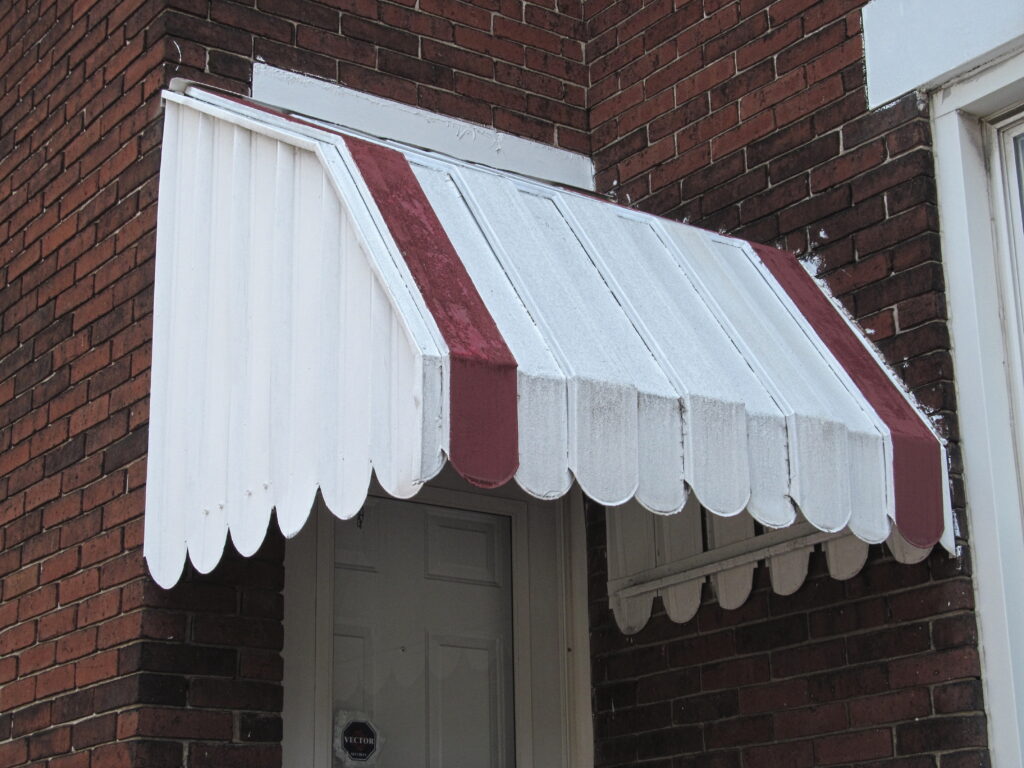
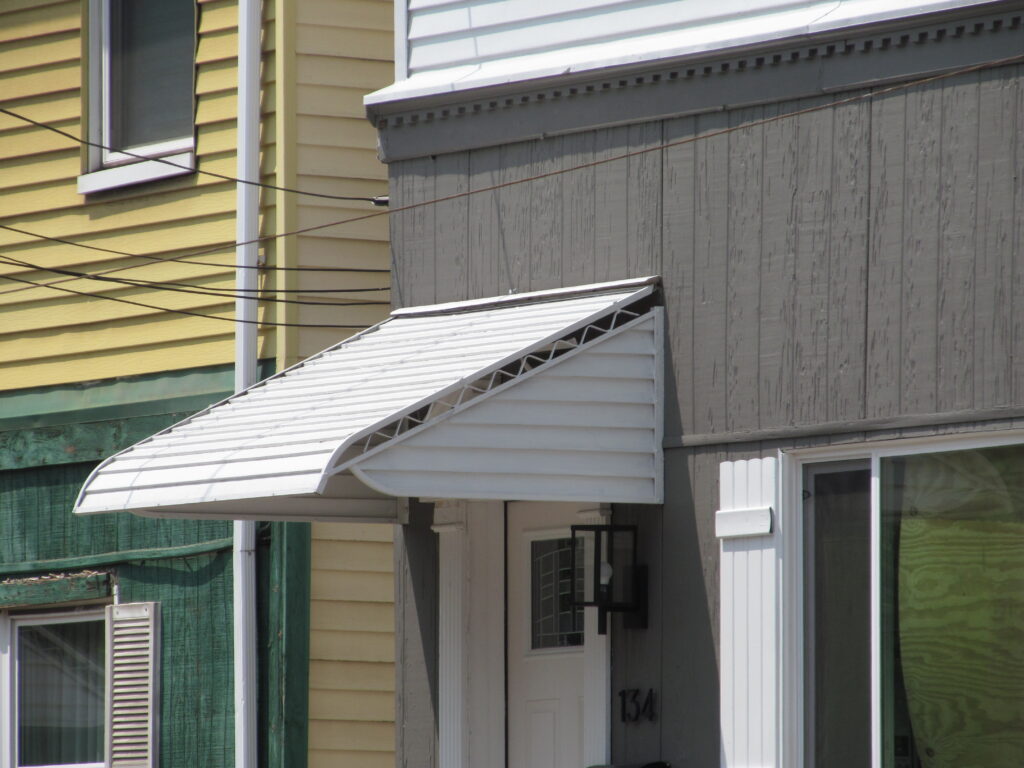
These awnings were made by a number of different manufacturers, and they came in a wide variety of shapes.
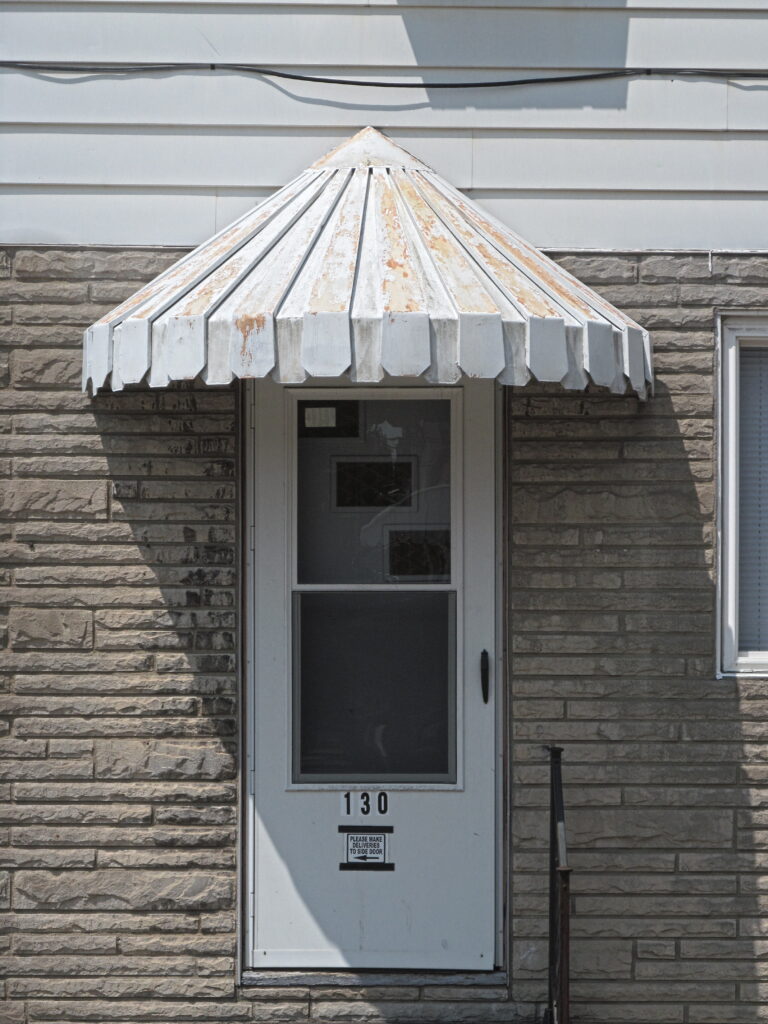
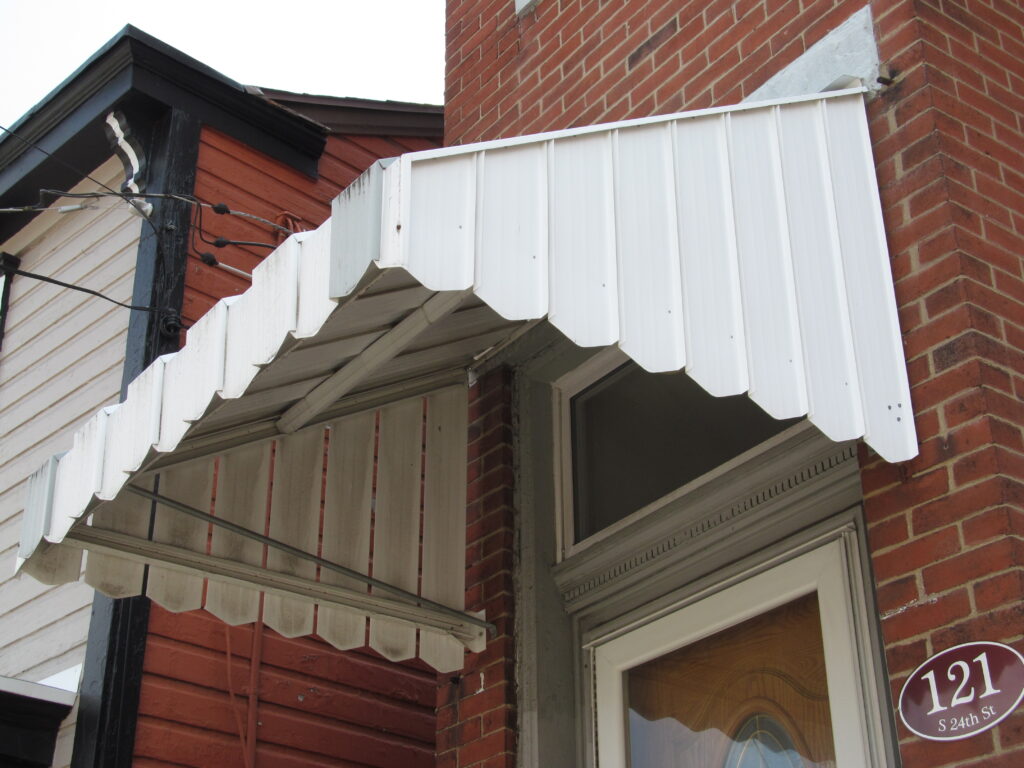
Aluminum awnings were supposedly open to the objection that, when the sun was beating on them, they created a pocket of hot air under them. (How much of a worry this really is old Pa Pitt could not tell you, but it sounded plausible in the mouth of a salesman.) The problem was supposedly solved, however, by the ingenuity of the Kool Vent Metal Awning Corp. of America,1 which invented and patented diagonal louvers on the sides of the awning that were supposed to allow the hot air to escape from under the awning—an invention described thus:
An awning adapted to be fastened to a wall or the like support, including a curtain comprising a series of spaced overlapping parallel vertical depending plates, angling outwardly from the awning toward the wall at not more than ninety degrees.
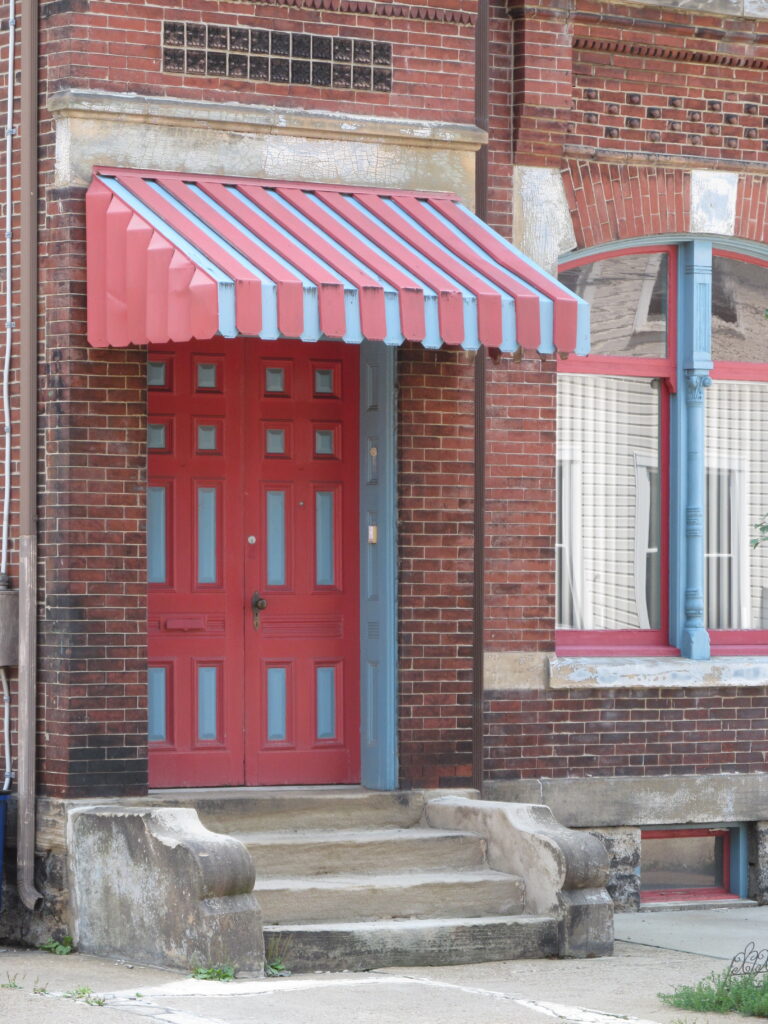
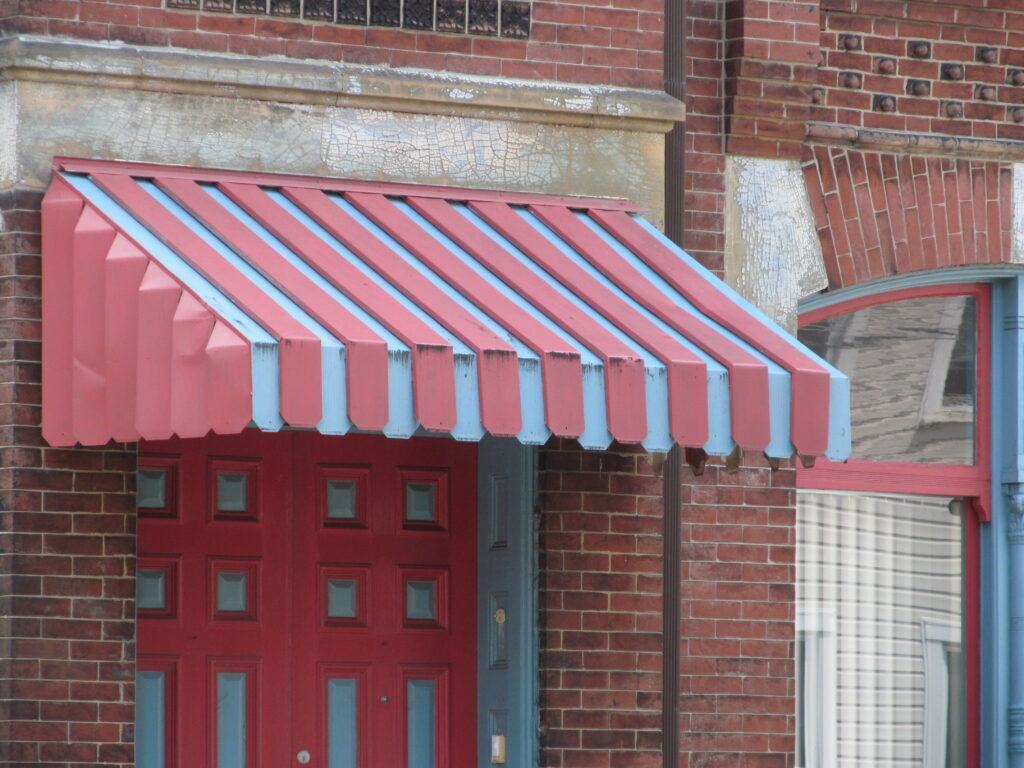
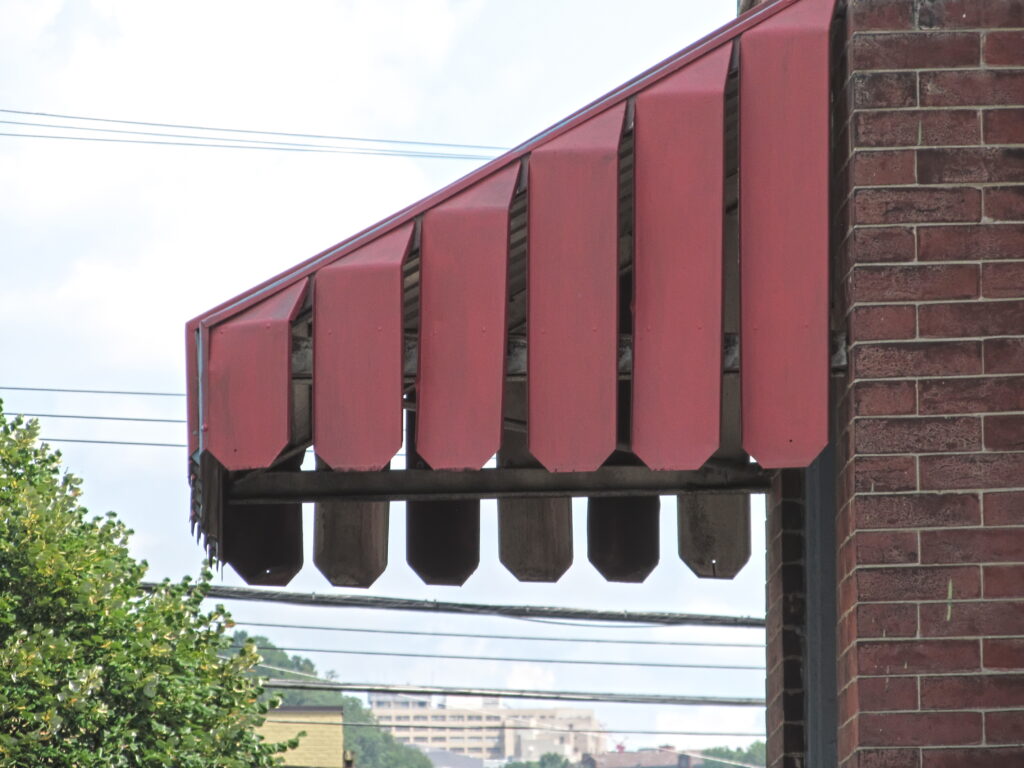
Here we see the diagonal arrangement, designed so that the “vertical depending plates” still provide reasonable shelter from blowing rain but allow air to escape between them. Other awning companies imitated this arrangement, but Kool Vent successfully sued them, enforced its patent, and became the king of the aluminum-awning companies.
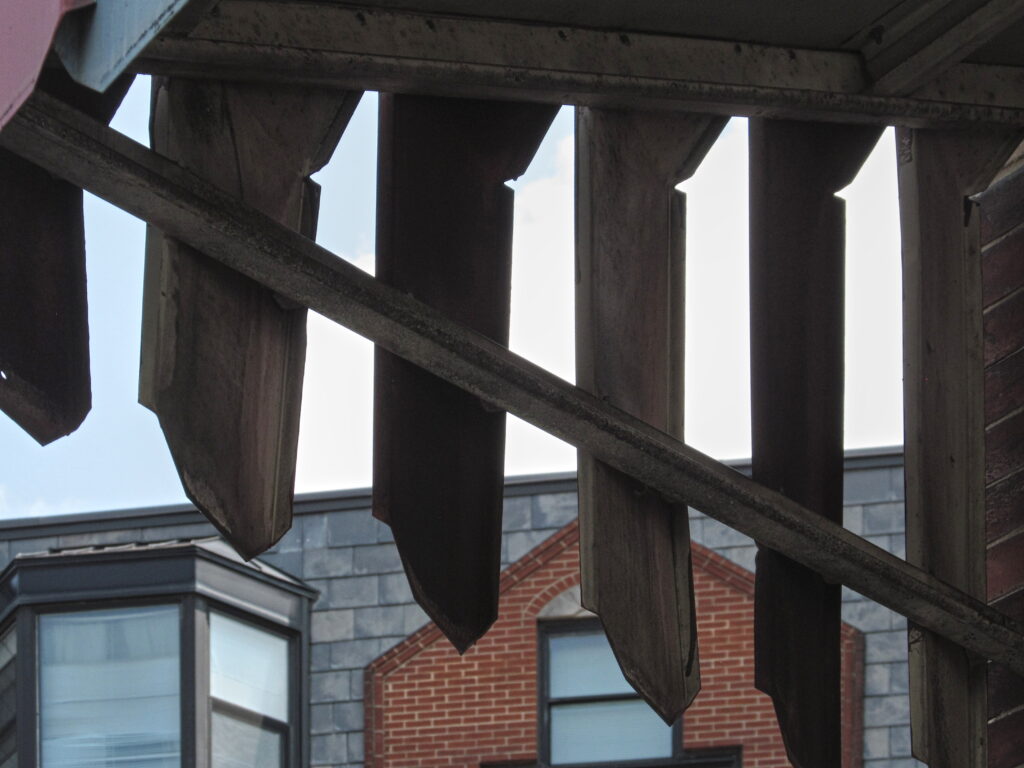
The architectural historian Franklin Toker facetiously suggested that the South Side should be declared a Kool Vent Awning historic district, and although other neighborhoods—Bloomfield, for example, and South Oakland—also have large Kool Vent infestations, the South Side probably preserves Kool Vent awnings and their competitors in greater numbers and density than any other neighborhood. All the awnings in this article were found in one block of South 24th Street.

A small but very rich classical bank still in use as a bank.


The clock suggests that the bankers will consult an astrologer before investing your money.


Stock-photo sites will charge you good money for patently metaphorical pictures like these. Yet old Pa Pitt gives them to you for free, released with a CC0 public-domain donation, so there are no restrictions on what you can do with them.


Cameras: Kodak EasyShare Z1285 (HDR stacks of three photographs); Canon PowerShot SX150 IS.

A towboat moored with a number of barges at Neville Island.

One of several round banks Mellon Bank built in the modernist era. It is still a bank, now belonging to Citizens Bank, Mellon’s successor in retail banking.

We also have a less abstract picture of the whole building.

Now the Coraopolis United Methodist Church. The father-and-son team of T. B. and Lawrence Wolfe, part of a century-long dynasty of Wolfes in Pittsburgh architecture, designed this church, built in 1924.

Our friend Dr. Boli had opinions about this picture.



The building this one replaced is also still standing—a typical late-1800s Pittsburgh Rundbogenstil church, and one with the sanctuary upstairs if you come in by the front door. It was a short block away, and it is still in use as a church, now Coraopolis Abundant Life Ministries.

Cameras: Kodak EasyShare Z1285; Canon PowerShot SX150 IS; Kodak EasyShare Z981.